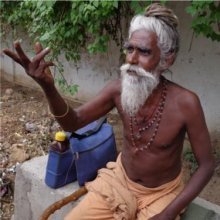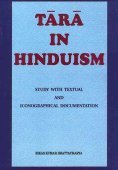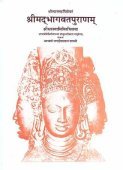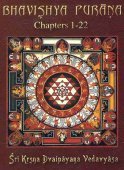Durvasa, Dur-vasa, Durvāsa, Durvāsā: 18 definitions
Introduction:
Durvasa means something in Hinduism, Sanskrit, the history of ancient India, Marathi. If you want to know the exact meaning, history, etymology or English translation of this term then check out the descriptions on this page. Add your comment or reference to a book if you want to contribute to this summary article.
Images (photo gallery)
In Hinduism
Purana and Itihasa (epic history)
Source: Wisdom Library: Bhagavata PuranaDurvāsā (दुर्वासा):—One of the sons of Atri and his wife Anasūyā. (see Bhāgavata Purāṇa 4.1.15)
Source: Cologne Digital Sanskrit Dictionaries: The Purana Index1a) Durvāsa (दुर्वास).—A son of Atri and an younger brother of Dattātreya;1 an aṃśa of Śiva;2 appeared before Ambarīṣa who was about to break his dvādasi fast; agreed to accept his hospitality, went to the river for bath and tarried there; finding the muhūrta for pāraṇa (break-fast) drawing to a close, the king broke his fast with some water. Coming to know of this on his return, the sage produced a flaming spirit to attack him. But Hari's cakra burnt it down and turned towards the sage, who ran for succour to Brahmā, Śiva and Viṣṇu. All of them were unable to help; but Hari advised him to meet Ambarīṣa and apologise to him.3 This he did and was set at liberty. After partaking the meals with him, he returned to Brahmaloka;4 blessed Pṛtha with secret mantras to summon gods.5 Through him Duryodhana planned to destroy the Pāṇḍavas by inciting him to go to them and ask for a feast. But Kṛṣṇa protected them on the occasion.6 In the course of his sojourn he met a Vidyādhara maid with a garland given to her by the Devī; took it from her and presented it to Indra who put it on his elephant, who in turn threw it on the ground and trampled upon it. Enraged at this, the sage cursed him to be lost to all fortune.7
- 1) Bhāgavata-purāṇa IV. 1. 15; Brahmāṇḍa-purāṇa III. 8. 82; Vāyu-purāṇa 70. 76.
- 2) Bhāgavata-purāṇa IV. 1. 33.
- 3) Ib. IX. 4. 35-71.
- 4) Ib. IX. 5. 1-22.
- 5) Ib. IX. 24. 32; XI. 1. 12.
- 6) Ib. I. 15. 11.
- 7) Ib. VIII. 5. 16; Brahmāṇḍa-purāṇa IV. 5. 16-20; 9. 31; 40. 120.
1b) A Siddha.*
- * Bhāgavata-purāṇa VI. 15. 13.
1c) One of the Sages who left for Piṇḍāraka.*
- * Bhāgavata-purāṇa XI. 1. 12.

The Purana (पुराण, purāṇas) refers to Sanskrit literature preserving ancient India’s vast cultural history, including historical legends, religious ceremonies, various arts and sciences. The eighteen mahapuranas total over 400,000 shlokas (metrical couplets) and date to at least several centuries BCE.
Shaivism (Shaiva philosophy)
Source: Shodhganga: Iconographical representations of ŚivaDurvāsa (दुर्वास) refers to one of the eighteen teachers of Āgama digests (paddhati) according to a theory where the sacred knowledge emanated from Śiva is said to have taught by Nandin to Sanaka, Sanātana, Sanandana and Sanatkumāra. Out of the four mutts established by them on the slopes of Himalayas, other eighteen mutts are established by Āgamic seers (e.g., Durvāsa), who authored the manuals named after their respective founders. The śaivāgama digests are termed as paddhati: manuals compiled by the teachers who have condensed the subject matter from the śloka-based Mūlāgamasand and presented them in the form of prayoga.

Shaiva (शैव, śaiva) or Shaivism (śaivism) represents a tradition of Hinduism worshiping Shiva as the supreme being. Closely related to Shaktism, Shaiva literature includes a range of scriptures, including Tantras, while the root of this tradition may be traced back to the ancient Vedas.
Pancaratra (worship of Nārāyaṇa)
Source: Wisdom Library: Pancaratra (Samhita list)1a) Dūrvāsa (दूर्वास) or Dūrvāsatantra is the name of an ancient Pāñcarātra Saṃhitā mentioned in the Kapiñjalasaṃhitā: a Pāñcarātra work consisting of 1550 verses dealing with a variety of topics such as worship in a temple, choosing an Ācārya, architecture, town-planning and iconography.—For the list of works, see chapter 1, verses 14b-27. The list [including Dūrvāsa-tantra] was said to have comprised “108” titles, these, different saṃhitās named after different manifestations of the Lord or different teachers. They are all said to be authoritative as the ultimate promulgator of all these is the same Nārāyaṇa.
1b) Durvāsa (दुर्वास) or Durvāsatantra is also mentioned in the Bhāradvājasaṃhitā or “Bhāradvāja-kaṇva-saṃhitā”: a Pāñcarātra text comprising some 230 ślokas mainly concerned with basic details concerning temple construction and icon consecration.—In the first chapter of the Bhāradvāja-Saṃhitā a list of canonical titles is given—supposedly, but not actually naming “108” titles. The list is almost identical to that found in the Kapiñjala-saṃhitā.
2) Dūrvāsa (दूर्वास) or Dūrvāsasaṃhitā is also mentioned in the Puruṣottamasaṃhitā: a Pāñcarātra text consisting of more than 1800 verses devoted to temple-building and the practical concerns of the Pāñcarātra priestly community.
3) Dūrvāsa (दूर्वास) or Dūrvāsasaṃhitā is also mentioned in the Mārkaṇḍeyasaṃhitā: a Pāñcarātra text comprising some 2200 Sanskrit verses mainly dealing with temple-building, iconography, pūjā (worship procedures), utsava (festivities) and prāyaścitta (expiatory measures).
Source: Shodhganga: Iconographical representations of Śiva (pancaratra)Durvāsa (दुर्वास) or Durvāsasaṃhitā is the name of a Vaiṣṇava Āgama scripture, classified as a sāttvika type of the Muniprokta group of Pāñcarātra Āgamas. The vaiṣṇavāgamas represent one of the three classes of āgamas (traditionally communicated wisdom).—Texts of the Pāñcara Āgamas are divided in to two sects. It is believed that Lord Vāsudeva revealed the first group of texts which are called Divya and the next group is called Muniprokta which are further divided in to three viz. a. Sāttvika (e.g., Durvāsa-saṃhitā). b. Rājasa. c. Tāmasa.

Pancaratra (पाञ्चरात्र, pāñcarātra) represents a tradition of Hinduism where Narayana is revered and worshipped. Closeley related to Vaishnavism, the Pancaratra literature includes various Agamas and tantras incorporating many Vaishnava philosophies.
Vaishnavism (Vaishava dharma)
Source: Pure Bhakti: Brhad BhagavatamrtamDurvāsā (दुर्वासा) refers to:—A powerful mystic yogī known for his fearsome curses; a partial incarnation of Śrī Śiva. (cf. Glossary page from Śrī Bṛhad-bhāgavatāmṛta).

Vaishnava (वैष्णव, vaiṣṇava) or vaishnavism (vaiṣṇavism) represents a tradition of Hinduism worshipping Vishnu as the supreme Lord. Similar to the Shaktism and Shaivism traditions, Vaishnavism also developed as an individual movement, famous for its exposition of the dashavatara (‘ten avatars of Vishnu’).
General definition (in Hinduism)
Source: WikiPedia: HinduismDurvāsa (दुर्वास): An ancient sage known for his anger who visited the Kauravas. Duryodhana asked him to visit his cousins, the Pandavas, hoping that they would incur his wrath.
India history and geography
Source: Wisdom Library: Teachers, Saints and SagesDurvasa refers to one of the Siddhars (Siddhas) and Rishis mentioned by Rangarasa Desiga Swamigal in his Siddhargal Potri Thoguppu. Each name in the list starts with prefix ‘Om’ followed by the Siddhar’s names and ends with refrain ‘Thiruvadigal Potri’. For example for Durvasa: ஓம் தூர்வாசமுனிவர் திருவடிகள் போற்றி [ōm tūrvācamuṉivar tiruvaṭikaḷ pōṟṟi].—These Siddhas experienced union with the ultimate reality and witnessed a spiritual transformation of their intellectual, mental, vital and ultimately, physical bodies.
Durvasa is also known as Tūrvācamuṉivar, Turvāca Muṉivar, Durvasa Munivar, Turvācar.
[For more information regarding Durvasa and other Maha-Siddhas, see the following sources: (1): the Pamphlet ‘Siddhargal Thiruvadi Potri’ issued by the Arulmighu Kalaikkōṭṭuar Sanmarga Sangam, Thanjavur; (2) List of Siddhas Compiled by Tavayogi Thangarasan Adigal of the Sri Agathiyar Sri Thava Murugan Gnana Peedam Thirukovil; (3) A list of 203 Sages compiled by Agathiyan production house; (4) The 12th-century Abhidhana-Chintamani lexicon by Hemachandra]

The history of India traces the identification of countries, villages, towns and other regions of India, as well as mythology, zoology, royal dynasties, rulers, tribes, local festivities and traditions and regional languages. Ancient India enjoyed religious freedom and encourages the path of Dharma, a concept common to Buddhism, Hinduism, and Jainism.
Languages of India and abroad
Marathi-English dictionary
Source: DDSA: The Molesworth Marathi and English Dictionarydurvāsa (दुर्वास).—m (S Proper name of a saint. He is celebrated as a great eater.) A term for a glutton.
Source: DDSA: The Aryabhusan school dictionary, Marathi-Englishdurvāsa (दुर्वास).—m A term for a glutton. A sage in Hindu Mythology.
Marathi is an Indo-European language having over 70 million native speakers people in (predominantly) Maharashtra India. Marathi, like many other Indo-Aryan languages, evolved from early forms of Prakrit, which itself is a subset of Sanskrit, one of the most ancient languages of the world.
Sanskrit dictionary
Source: DDSA: The practical Sanskrit-English dictionaryDurvasa (दुर्वस).—a. difficult to be resided in.
Durvasa is a Sanskrit compound consisting of the terms dur and vasa (वस).
Source: Cologne Digital Sanskrit Dictionaries: Benfey Sanskrit-English DictionaryDurvasa (दुर्वस).—i. e. dus-vas + a, adj. 1. Difficult to dwell, Mahābhārata 4, 93. 2. Difficult to be passed (as time), Mahābhārata 4, 7.
Source: Cologne Digital Sanskrit Dictionaries: Cappeller Sanskrit-English DictionaryDurvasa (दुर्वस).—[neuter] (it is) bad dwelling.
Source: Cologne Digital Sanskrit Dictionaries: Monier-Williams Sanskrit-English Dictionary1) Durvasa (दुर्वस):—[=dur-vasa] [from dur] n. ([impersonal or used impersonally]) d° to be resided in ([locative case]), [Mahābhārata iv, 93]
2) [v.s. ...] mfn. d° to be passed or spent (time), 7
3) [v.s. ...] d° to be stayed with, causing ill luck by one’s presence, [Rāmāyaṇa vii, 86, 12; 17.]
4) Durvāsa (दुर्वास):—[=dur-vāsa] [from dur] m. (cf. -vāsas) [probably] = sācārya m. Name of a Ṛṣi, [Catalogue(s)]
[Sanskrit to German]
Sanskrit, also spelled संस्कृतम् (saṃskṛtam), is an ancient language of India commonly seen as the grandmother of the Indo-European language family (even English!). Closely allied with Prakrit and Pali, Sanskrit is more exhaustive in both grammar and terms and has the most extensive collection of literature in the world, greatly surpassing its sister-languages Greek and Latin.
Kannada-English dictionary
Source: Alar: Kannada-English corpusDurvāsa (ದುರ್ವಾಸ):—
1) [noun] = ದುರ್ವಾಸನೆ - [durvasane -] 1.
2) [noun] (fig.) an object, behaviour, incident, etc. that helps to solve a problem or mystery; a clue.
Kannada is a Dravidian language (as opposed to the Indo-European language family) mainly spoken in the southwestern region of India.
Nepali dictionary
Source: unoes: Nepali-English DictionaryDurvāsā (दुर्वासा):—n. 1. Mythol. a hotheaded and much feared sage; 2. a hotheaded person;
Nepali is the primary language of the Nepalese people counting almost 20 million native speakers. The country of Nepal is situated in the Himalaya mountain range to the north of India.
See also (Relevant definitions)
Partial matches: Dur, Vasa, Door, Vaca, Tur.
Starts with (+4): Durvasa-munivar, Durvasacarya, Durvasamuni, Durvasane, Durvasane-mara, Durvasapurana, Durvasas, Durvasasa, Durvasasamhita, Durvasasana, Durvasasokta, Durvasasoktapurana, Durvasatantra, Durvasati, Durvasaupakhyana, Durvasaupapurana, Durvashana, Durvasopakhyana, Durvasopapurana, Turvacam.
Query error!
Full-text (+126): Durvasas, Durvasopapurana, Durvasopakhyana, Kusharani, Durvasapurana, Durvasasamhita, Anasuya, Durvasasana, Daurvasa, Daurvasasa, Kunti, Atri, Upapurana, Satyatapas, Turuvacam, Turuvacan, Durvasamuni, Turvacam, Durvasomahiman, Durvasovakya.
Relevant text
Search found 106 books and stories containing Durvasa, Dur-vāsa, Dur-vasa, Durvāsa, Durvāsā, Dūrvāsa; (plurals include: Durvasas, vāsas, vasas, Durvāsas, Durvāsās, Dūrvāsas). You can also click to the full overview containing English textual excerpts. Below are direct links for the most relevant articles:
Garga Samhita (English) (by Danavir Goswami)
Verse 4.1.18 < [Chapter 1 - The Story of the Personified Vedas]
Verses 2.11.35-37 < [Chapter 11 - The Liberation of Dhenukāsura]
Verse 4.1.52 < [Chapter 1 - The Story of the Personified Vedas]
Puranic encyclopaedia (by Vettam Mani)
Studies in the Upapuranas (by R. C. Hazra)
Skanda Purana (by G. V. Tagare)
Chapter 99 - Sage Durvāsa Visits Rāma < [Section 1 - Tīrtha-māhātmya]
Chapter 236 - Greatness of Durvāsāditya (Durvāsa-āditya) < [Section 1 - Prabhāsa-kṣetra-māhātmya]
Chapter 49 - King Kalaśa Turns into a Tiger < [Section 1 - Tīrtha-māhātmya]
The history of Andhra country (1000 AD - 1500 AD) (by Yashoda Devi)
Part 31 - Virasavaranatha < [Chapter XIII - The Dynasties in South Kalinga]
Brihad Bhagavatamrita (commentary) (by Śrī Śrīmad Bhaktivedānta Nārāyana Gosvāmī Mahārāja)
Verse 1.4.13 < [Chapter 4 - Bhakta (the devotee)]
Verse 1.4.33 < [Chapter 4 - Bhakta (the devotee)]
Verse 1.5.39 < [Chapter 5 - Priya (the beloved devotees)]
Related products




